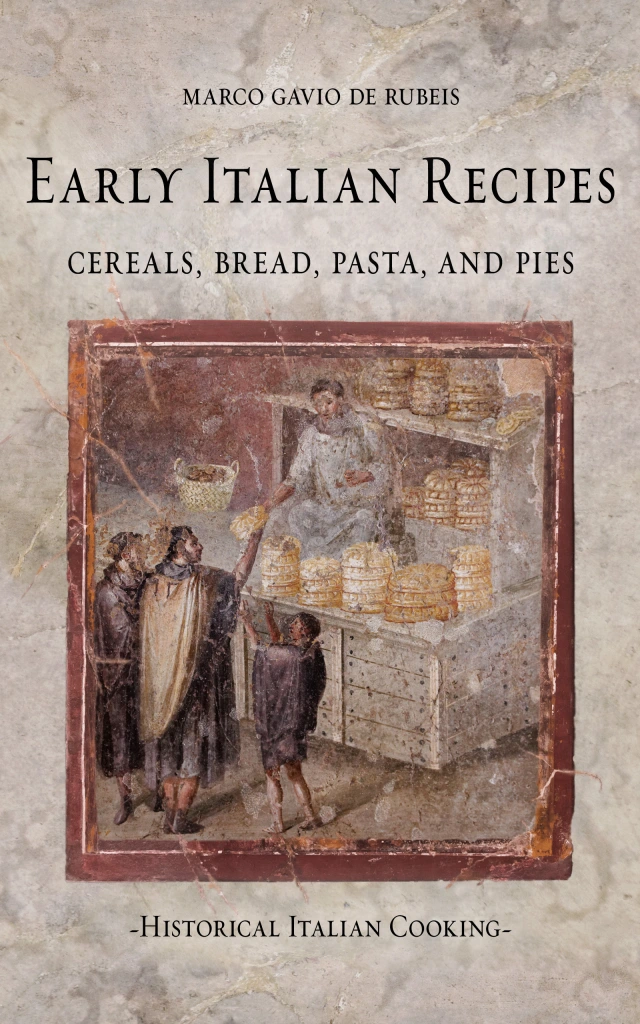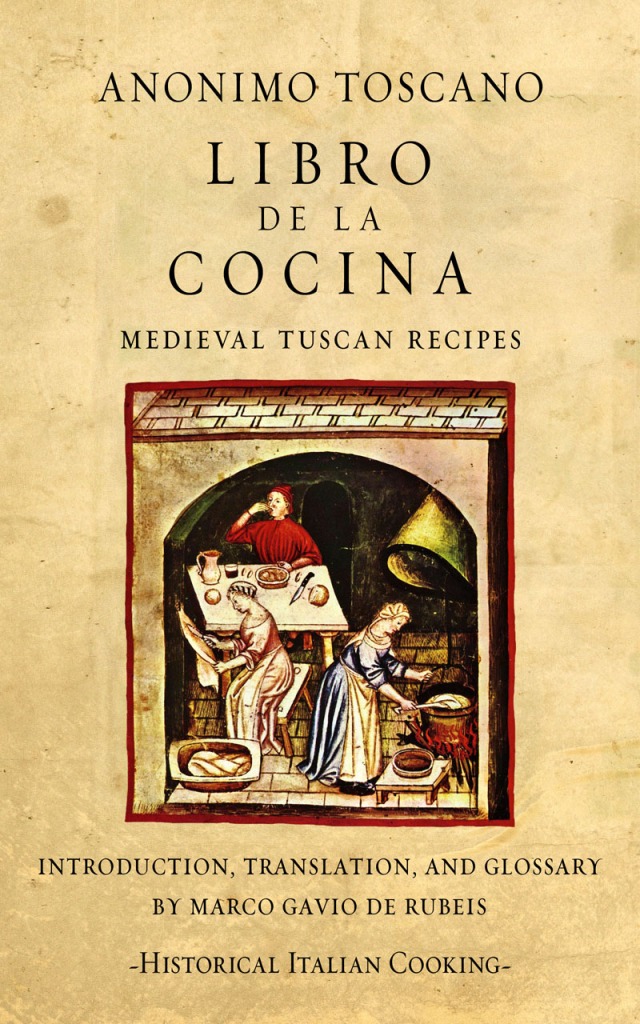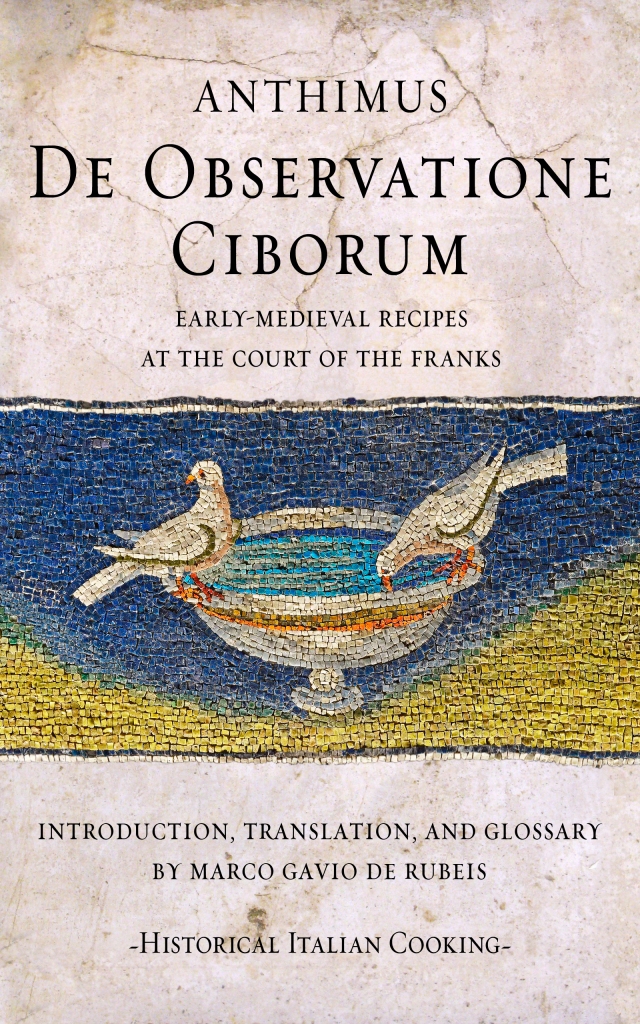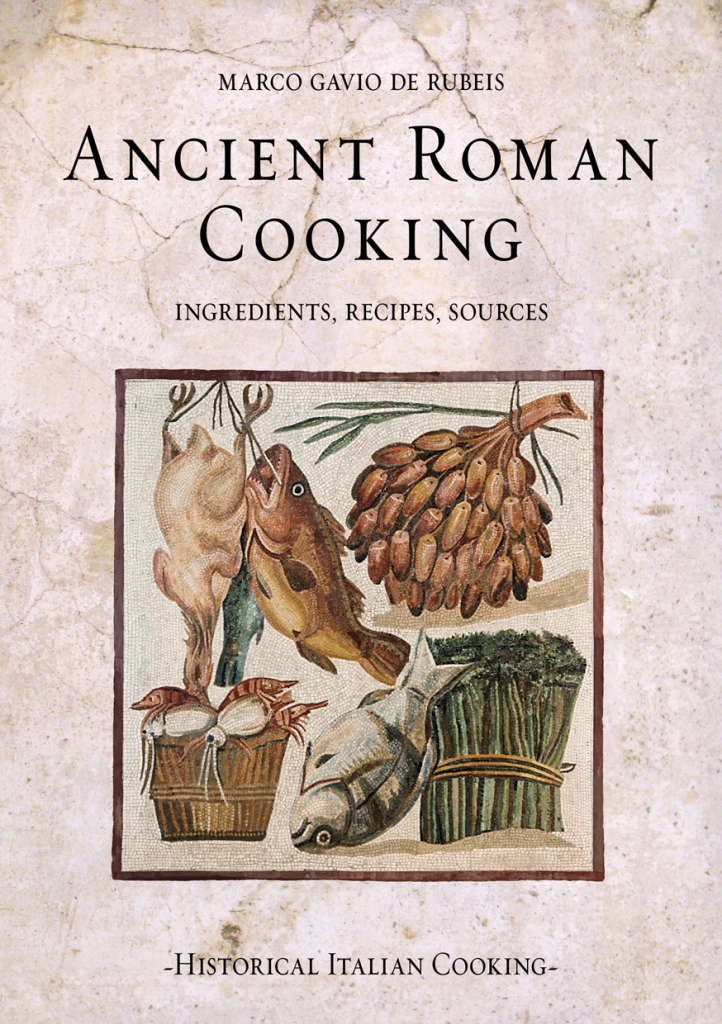So far, we have published six books in English (and a few more in Italian), but we are working on others that will be available soon. We have published a book on food in ancient Rome in 2020, three translations of medieval sources, and two books in the series Early Italian Recipes, one dedicated to vegetables, fruit, herbs, and flowers and the other to cereals, bread, pasta, and pies between the Antiquity and early Modern Era. New volumes in this series will be published in the next years and will treat historical recipes for meat, fish, sweets, and beverages.
Our translations are Johannes Bockenehim’s Registrum Coquine, dating to the 15th century, an early-medieval book titled De Observatione Ciborum, written by the Byzantine physician Anthimus in the 6th century, and Anonimo Toscano’s Libro de la Cocina (14th century).

Our new book Early Italian Recipes. Cereals, bread, pasta, and pies is available on Amazon in English and Italian.
The book, part of the series Early Italian Recipes (Antiche Ricette Italiane in the Italian edition), is entirely dedicated to historical recipes for cereals, with historical preparations of pasta, pizza, bread, pies, focaccia, and much more, starting from the Antiquity to the beginning of the modern era. Each volume is independent and can be read in any order.
In the first part of the book, you will find a description of the sources used for writing it and a theoretic explanation of the use of the ingredients and the history of the preparations through time by analyzing several primary sources that describe them. In the second part, you will find 114 recipes for all kinds of cereal dishes, including some of the oldest preparations for pasta ever written down in our country through the methods for ancient tracta found in Cato’s De Agri Cultura and Athenaeus’ Deipnosophistae, as well as the first preparations of pizza and lasagna, a dish whose origins are rooted in ancient Greece.
“Cereals have been a staple food in Italy since the Antiquity. Several primary sources describe the methods of preparing them, encompassing many fields of knowledge, from agriculture to cooking and medicine, with a common thread: food is not only pleasure but also tradition and a primary means of achieving good health.
Through the analysis of original texts from the Antiquity to the Renaissance and beyond, this book will explore the evolution of terms and preparations that connect us to the origins of Italian food culture. Because the history of dishes like pasta and lasagna began earlier than commonly thought, and pizza is much more than a pie with tomato and mozzarella.
With this second volume of the series Early Italian Recipes, we present 114 historical recipes for cereals, bread, pasta, pies, and pizza, newly translated and explained, so that you can experiment with authentic techniques handed down through the generations and travel into the gastronomic past that has shaped the Italian cuisine we still enjoy today.”

Libro de la Cocina. Medieval Tuscan Recipes, also known as Anonimo Toscano, is available on Amazon in print and e-book editions in English and Italian. Written in Tuscan vernacular by an anonymous author and also known as Anonimo Toscano, this cookbook collects 175 recipes for all the main medieval preparations, from pies and pasta to dishes with meat, fish, eggs, and vegetables for the fat and lean days. Our book contains an introduction about the ingredients and basic preparations, the translation, and a glossary.
“Written in the 14th century by an anonymous Tuscan author, the Libro de la Cocina is one of the first cookbooks in Italian vernacular and records the beginning of a culinary tradition that still survives today in many recipes of Central Italy, especially Umbria and Tuscany.
Creative and colorful with many vegetables, spices, and herbs, this book shows us a whole world of recipes for meat, fish, pasta, pies, and other dishes with variants for the fat and lean days, with plenty of details and suggestions that make it a complete handbook essential to understand the principles at the basis of medieval cuisine and learn how to create authentic, historical plates. With its 175 recipes, the Libro de la Cocina is one of the most interesting medieval cookbooks, easy to follow and practice, perfect for our journey into history through the origin of Italian cooking.
To make this source easier to read, we accompanied our translation with notes that compare the text with others written in the same period, in particular the Liber de Coquina, a glossary, and an introduction about the ingredients and preparations, which includes an explanation of the basic methods taken for granted by the medieval author.”

Early Italian Recipes. Vegetables, fruit, herbs, and flowers, is available on Amazon in print and e-book editions, in English and Italian, is the first of a series that explores the history of Italian cuisine through specific ingredients and preparations. In the next years, we will publish further books on cereals (pasta, bread, and pies), meat, fish, sweets, and beverages, in addition to translations of historical sources from the Antiquity to the Middle Ages.
Colorful and full of flavors, Italian cuisine is characterized from its origin by a substantial use of wild and cultivated herbs, vegetables, legumes, but also fruit and flowers, which appear not only in recipes for sweets but also in savory dishes.
Our book is divided into two parts: the first is a historical introduction; the second collects several recipes taken from sources on cooking, dietetics, and agronomy from the Antiquity to the beginning of the Modern Era. In the introduction, we explore the philosophical and religious basis of the consumption of vegetable ingredients, in particular the Pythagorean diet and the practice of the lean days in the Middle Ages and Renaissance; then, we examine the preparation of salads, considered a staple of the Italian diet, described by physicians, cooks, and naturalists; finally, we gave a series of practical suggestions about the basic recipes and ingredients, in particular how to substitute the ones most difficult to find. The second part includes various preparations, among which recipes completely excluding dairy products and eggs, for soups salads, sauces, stews, fritters, and other dishes, with all kinds of vegetables and legumes, some of which used today mainly in some regional traditions, through a journey back in the past to restore an amazing cultural heritage that deserves to be rediscovered.
“Vegetables opened the ancient banquets, as recalled by Martial, and were a fundamental part of the diet of our Roman and medieval ancestors. Legumes, fruit, aromatic herbs, mushrooms, and even flowers were cooked in plenty of ways to prepare stews, fritters, soups, frittatas, and other dishes.
Salads, made with roots, greens, and flowers, simple or mixed, raw, fried, cooked under the ashes, or simmered, are mentioned not only in the sources on cooking and dietetics but even in the literary texts as a delicacy particularly appreciated in Italy that characterized the diet of our country according to Renaissance authors such as Costanzo Felici and Giacomo Castelvetro.
Starting from the uses of ancient Romans and the philosophical beliefs of the Pythagoreans, who promoted a diet mostly based on vegetables, we analyzed the religious practice of the lean days in the Middle Ages reaching the end of the Renaissance with plenty of fascinating recipes that, throughout the centuries, became a tradition.
The first book of a new series that explores the complexity of the early Italian cuisine, which partially survives in regional cooking, with historical recipes for all kinds of vegetables, translated and explained, selected from cookbooks and dietetic, agronomy, and naturalistic sources written between the Antiquity and early Modern Era.”
On Amazon, you also find De Observatione Ciborum. Early-medieval recipes at the court of the Franks, in English and Italian. Written in the 6th century by the Byzantine physician Anthimus as a letter to Theuderic, the king of the Franks, De Observatione Ciborum is one of the earliest medieval sources on cooking and dietetics written in Latin, which shows the moment of passage between ancient and medieval traditions, with a focus on the foods and beverages used by the Franks. In our book, like in the previous Registrum Coquine. A medieval cookbook, you will find not only the translation of this text but also an introduction that puts Anthimus’ work into context and a glossary with the peculiar Latin used by this non-native author.
The book is available in e-book and printed editions.

“Halfway between a dietetic treatise and a cookbook, De Observatione Ciborum was written in the 6th century by the Byzantine physician Anthimus as a letter to Theuderic, the king of the Franks. Through the descriptions of the aliments, their properties, and the healthiest methods to prepare them, Anthimus shows the uses of the Franks, revealing the differences between them and the Mediterranean peoples and at the same time the similarities, especially in the language and traditional foods and beverages such as tesana, melca, wormwood wine, laredum, or mead, and recording the passage from a culinary culture based on olive oil to one that prefers animal fats.
De Observatione Ciborum is a fascinating reading, in which a peculiar Latin is used as a lingua franca between two non-native speakers, a source that allows the enthusiast of food history to catch a glimpse of a fundamental cultural metamorphosis and understand how the ancient traditions will transform throughout the centuries to become something new though deeply rooted in the past.”

The Registrum Coquine by Johannes Bockenheim is a beautiful 15th-century cookbook, available on Amazon in English and Italian.
The text, present in two different manuscripts, collects more than 80 recipes for the fat and lean days, with several methods for meat, fish, pies, sweets, stews, soups, and other dishes. The peculiarity of the Registrum Coquine is that all the recipes are suggested to specific social classes or nationalities, so we find foods destined to peasants and princes, laics and mercenaries, prostitutes and actors, in a colorful representation of medieval society.
In the introduction, we explored the relationship between foods and social classes, the ingredients, the sources, the basic preparations given for granted by the author, confronting the information offered by this text with other primary sources between the Antiquity and Renaissance.
We did not write this book specifically for scholars, but for enthusiasts and everyone who wants to know more about medieval foods and perhaps prepare the recipes at home, reading an original source directly.
Moreover, the Registrum Coquine is the perfect cookbook to get started with medieval cuisine. It is simpler than others written in the same period and most recipes are easy to recreate, with the need of just a few additional recommendations meant for beginners. It is perfect not only because it is simple, but also because the author uses a few well-selected ingredients, which we explained in detail in the introduction.
It is important to remember that the Registrum Coquine is part of a precise historical context, and this means that the author is addressing his work to a reader who knows his language, the basic methods; a reader who shares with him centuries of traditions. For this reason, we need, first of all, to understand what he intends comparing the text with other sources, near or distant in time, that refer to the same tradition, to the same concepts and culinary ideas.
This book can be used in many ways: as a general introduction to medieval cooking, as a translation (with the glossary of Bockenheim’s terms), or as a handbook to actually prepare medieval recipes starting from scratch, something that our follower asked us several times. We believe that the interest in historical cuisine should not be exclusively academic, but also practical, to rediscover an extraordinary gastronomic patrimony that deserves to be known in its authenticity. And the best way to know historical cuisine is to try the recipes.

Ancient Roman Cooking. Ingredients, recipes, sources is available on Amazon. Here you find the Italian edition.
The first part of the book is dedicated to the sources and our method of research, with chapters about how ancient Romans experienced food between the richest convivia and simple meals, in the city and countryside, seen by authors and poets as an idyllic place of abundance distant from the chaos of the Urbs. The second part explains the ingredients available in ancient Rome, with particular attention to the villae, and the ways to preserve foods, from vegetables and fruit to cheese, meat, fish, garum, wine, oil, and honey. In the third part, there are the recipes, selected from Pliny, Columella, Palladius, Cato, and De Re Coquinaria, the cookbook conventionally attributed to Apicius.
On Amazon, you find a preview of the book with the index.
“Ancient Roman gastronomy was famous for an incomparable skill in the art of pairing the ingredients, with its Mediterranean flavors and healthy balance among the aromas.
Many sources record the greatness of Roman cuisine. Writers and poets celebrate its beauty, complexity, decadence, and at the same time, its simplicity. Agronomists tell the life in the countryside, showing the farming techniques and the preparation of common preserves, from cured meat to cheese, vegetables, fruit. Cooks focus on providing unique sensorial experiences through the learned use of ingredients that belong to our history, now almost forgotten. Silphium, garum, mulsum, allec, sapa are just some of them.
A journey back in time through ingredients and recipes, from the republican age to the empire, to rediscover an extraordinary culinary tradition that will satisfy, still today, the most refined palates.”